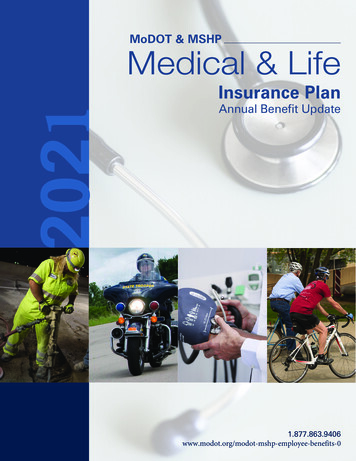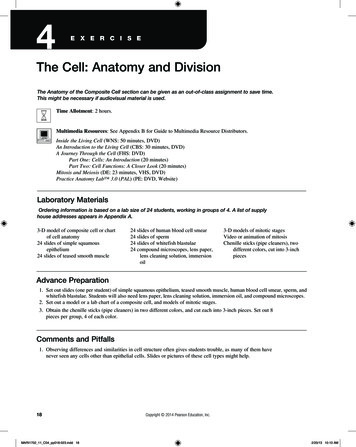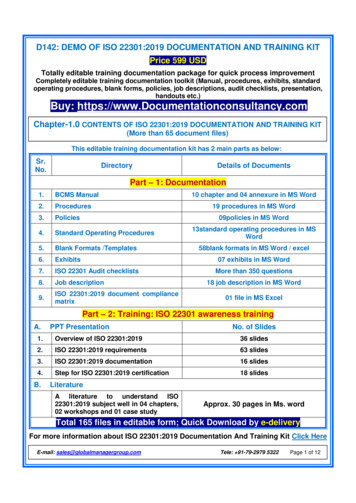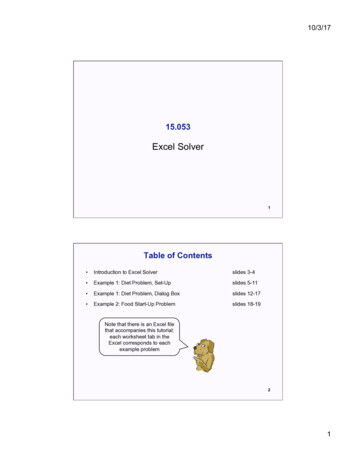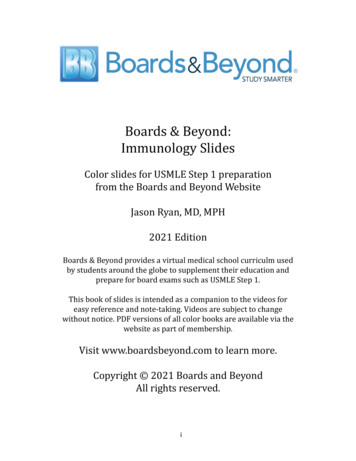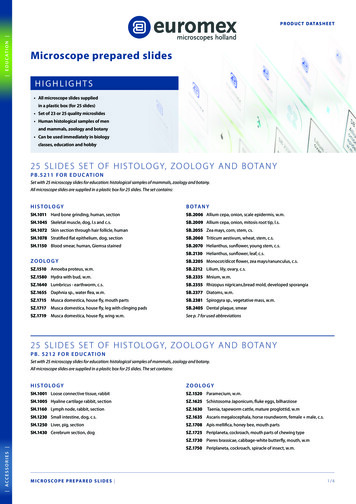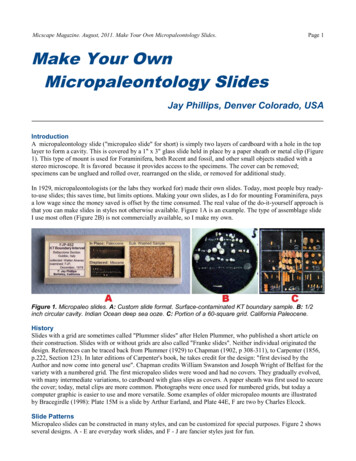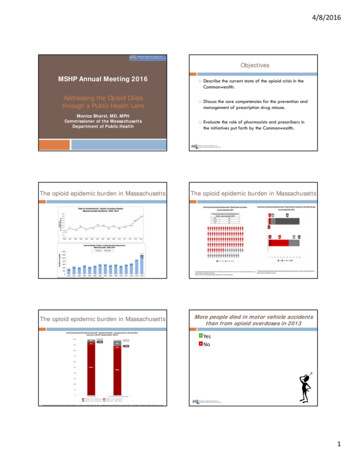
Transcription
4/8/2016ObjectivesMSHP Annual Meeting 2016Addressing the Opioid Crisisthrough a Public Health LensMonica Bharel, MD, MPHCommissioner of the MassachusettsDepartment of Public Health Describe the current state of the opioid crisis in theCommonwealth.Discuss the core competencies for the prevention andmanagement of prescription drug misuse.Evaluate the role of pharmacists and prescribers inthe initiatives put forth by the Commonwealth.The opioid epidemic burden in MassachusettsThe opioid epidemic burden in MassachusettsThe opioid epidemic burden in MassachusettsMore people died in motor vehicle accidentsthan from opioid overdoses in 2013YesNo1
4/8/2016Progress To-DateGovernor Baker’s Opioid Working GroupPrevention Intervention Treatment Recovery Substance Use Disorders: AddressingOpioid OverdosesVision:Adding over 200 new treatment beds across the state;Working to redesign, redevelop and relaunch the Prescription Monitoring Program (PMP) online system;Passing legislation requiring pharmacists to enter data into the PMP within one business day (24 hours), downfrom 7 days of receipt of prescription;Establishment of a cross‐institutional agreement by the Commonwealth’s four medical schools and theMassachusetts Medical Society in developing a first‐in‐the‐nation, cross‐institutional set of core competenciesthat will be incorporated in all of the medical school’s curriculum for medical students, ensuring critical andnecessary best practices for prescription drug use and management are taught;Establishment of a cross‐institutional agreement by the Commonwealth’s three dental medicine schools and theMassachusetts Dental Society mirroring the medical schools in developing a cross‐institutional set of corecompetencies;Holding Drug Take‐Back Day at 133 sites across the Commonwealth to collect unused prescription drugs for safedisposal;Convening of the state’s Drug Formulary Commission;Reinforcing the requirement that all DPH licensed addiction treatment programs must accept patients who areon methadone or buprenorphine medication;Planning for the transfer of women civilly committed under Section 35 at MCI Framingham to Taunton StateHospital by Spring 2016;Issuance of Division of Insurance guidelines to commercial insurers on the implementation of the substance usedisorder recovery law (Chapter 258) which requires insurers to cover the cost of medically necessary clinicalstabilization services for up to 14 days without prior authorization;Improving the affordability of naloxone for all 351 Massachusetts communities through a state bulk purchasingarrangement;Strengthening the state’s commitment to residential recovery programs through rate increasesGovernor Baker’s Opioid Working GroupCurb the rate of increase of opioid related overdose deaths.Goal: Decrease the number of opioid overdose deaths through a multi‐prong approach, including increasing thenumber of providers actively using the Prescription Monitoring Program by 80%; increase enrollments for servicesby 10%.Prevention Intervention Treatment RecoveryRationale: Factors contributing to opioid overdose deaths include limited access to treatment andprescription drug abuse.Notes: Estimatedopioid relatedoverdose deathsbased on 5% annualdecrease.PMP estimates onlyincludes providersand not delegates.Survey: reason for prescriptionpainkiller misuseFraming Core Competencies Core competencies are framed from the perspective of an encounterwith a patient who typically presents with pain (including dental ororofacial) and/or other symptoms for which a prescription medicationwith the potential for misuse may be indicated.Too easy to buy prescription painkillersillegallyPainkillers are prescribed too often or indoses that are bigger than necessaryToo easy to get painkillers from those whosave pills58%50%47%Source: Boston Globe and Harvard T.H. Chan School of Public Health,Prescription Painkiller Abuse: Attitudes among Adults in Massachusettsand the United States The goal of the stated core competencies is to support futureprescribers, over the course of their education and at the time prescribinghabits are being formed, with both skills and a foundational knowledge inthe prevention of prescription drug misuse, serving as a vital bridgebetween student education and residency training and/or practice. The Working Groups recognizes these competencies as integral to theabilities of all students, residents, and practicing prescribers to safely andcompetently prescribe prescription drugs, and to successfully prevent,identify, and treat substance use disorders.2
4/8/2016Medical Core Competencies:Primary Prevention Domain Preventing Prescription Drug Misuse:Screening, Evaluation, and Prevention1. Evaluate a patient’s pain using age, gender, and culturally appropriate evidence‐basedmethodologies.2. Evaluate a patient’s risk for substance use disorders by utilizing age, gender, and culturallyappropriate evidence‐based communication skills and assessment methodologies,supplemented with relevant available patient information, including but not limited tohealth records, family history, prescription dispensing records (e.g. the Prescription DrugMonitoring Program or “PMP”), drug urine screenings, and screenings for commonly co‐occurring psychiatric disorders (especially depression, anxiety disorders, and PTSD).3. Identify and describe potential pharmacological and non‐pharmacological treatmentoptions including opioid and non‐opioid pharmacological treatments for acute andchronic pain management, along with patient communication and education regardingthe risks and benefits associated with each of these available treatment options.Medical Core Competencies:Tertiary Prevention Domain Managing Substance Use Disorders as a Chronic Disease:Eliminate Stigma and Build Awareness of Social DeterminantsMedical Core Competencies:Secondary Prevention Domain Treating Patients At‐Risk for Substance Use Disorders: EngagePatients in Safe, Informed, and Patient‐Centered TreatmentPlanning4. Describe substance use disorder treatment options, including medication‐assistedtreatment, as well as demonstrate the ability to appropriately refer patients to addictionmedicine specialists and treatment programs for both relapse prevention and co‐occurring psychiatric disorders.5. Prepare evidence‐based and patient‐centered pain management and substance usedisorder treatment plans for patients with acute and chronic pain with special attentionto safe prescribing and recognizing patients displaying signs of aberrant prescription usebehaviors.6. Demonstrate the foundational skills in patient‐centered counselling and behavior changein the context of a patient encounter, consistent with evidence‐based techniques.Most individuals who use prescription opioidsnon-medically obtain the pills from a drug dealeror stranger.TrueFalse7. Recognize the risk factors for, and signs of, opioid overdose and demonstrate the correctuse of naloxone rescue.8. Recognize substance use disorders as a chronic disease by effectively applying a chronicdisease model in the ongoing assessment and management of the patient.9. Recognize their own and societal stigmatization and biases against individuals withsubstance use disorders and associated evidence‐based medication‐assisted treatment.10. Identify and incorporate relevant data regarding social determinants of health intotreatment planning for substance use disorders.Governor Baker’sOpioid Working GroupOpioid misuse educationPrevention Intervention Treatment Recovery#State Without StigMAHelpLine1-800-327-50503
4/8/2016Quantity of Prescriptions, AnnuallyQuantity of Prescriptions, AnnuallyMA Prescription Monitoring Program County‐Level Data Measures(Calendar Year 2015 Quarter 3)This table includes all Schedule II and III opioid prescriptionsdispensed and reported to the MA Online PMP, for both in‐ andout‐of‐state residents.Three Key Stakeholdersin Naloxone ExpansionReversing an Overdose: Use of NaloxoneBystandersFirst RespondersPharmacies/Prescribers22Bystander program modelOne statewide medical director who authorizes the training anddistribution under a standing order.The naloxone is purchased by the DPH State Office of Pharmacy Serviceswith funds from the DPH Bureau of Substance Abuse Services under theMedical Director’s license. Programs receive naloxone and atomizers from DPH BSAS program.Assemble kits, and then train/distribute.Full kit is two doses, two nasal atomization delivery devices, andinstructions for use.Training includes how to reduce risk and prevent an overdose, recognizesigns of an overdose, access emergency medical services, and administerintra‐nasal naloxone.Bystanders are instructed to deliver naloxone when opioid overdose occursin addition to other prevention/intervention. After being trained, each23participant receives a naloxone kit.Fatal opioid overdose rates reduced whereOEND implementedNaloxone coverage per 100K250Opioid overdose death rate100%90%20080%70%1505040%Nocoverage30%1-100 ppl20%10%046% reduction60%50%10027% reduction100 ppl0%Walley et al. BMJ 2013; 346: f174.4
4/8/2016Three Key Stakeholdersin Naloxone ExpansionFirst responders modelIn emergency situations, historically only paramedics haveadministered naloxone via injection in the event of an overdose. 2005, the Boston EMS applied for a Special Project Waiver fromthe DPH Office of Emergency Medical Services (OEMS) allow EMT’s to administer naloxone via intra‐nasal spray. first use of intra‐nasal administered naloxone inMassachusetts. 2010 DPH began a pilot program to equip First Responders withintra‐nasal naloxone. 2014 regulations amended to allow first responders to carrynaloxone with medical director oversight BystandersFirst RespondersPharmacies/Prescribers25Police & Fire naloxone rescues2010-2014(Massachusetts DPH First Responder Pilot)26Prescribers and Pharmacists350Bystanders300Rescues and deaths, 2010‐2014250200100160111500First igns of life, but died20122013Dead on arrival2014Rescue28Pharmacies and prescribers model Historically, writing a prescription for naloxone to a person at risk of anoverdose not common clinical practice and pharmacies were not equippedto fill prescriptions for naloxone. Some inpatients, emergency departments, health centers developedstanding orders for hospital pharmacies to furnish naloxone on discharge 2014: DPH regulation change to permit standing order narcan in pharmacies Allow pharmacists to establish a standing order with a prescriber fordispensing naloxone rescue kits. MassHealth and other insurers cover prescriptions for naloxone. When a pharmacy has an established standing order for naloxone,customers do not need a prescription to be dispensed a naloxone rescuekit. The customer’s insurance will be billed and a co‐pay or full price will be29charged depending on the insurance coverage.Naloxone (i.e. Narcan) use results in a 46%reduction in opioid overdose deaths incommunities.TrueFalse5
4/8/2016Governor Baker’sOpioid Working GroupOther Highlighted Progress to date Prevention Intervention Treatment RecoveryRedesigning, redeveloping and relaunching the PrescriptionMonitoring Program (PMP) online system;Passing legislation requiring pharmacists to enter data into thePMP within one business day (24 hours), down from 7 days ofreceipt of prescription;Holding Drug Take‐Back Day at 133 sites to collect unusedprescription drugs for safe disposal;Convening of the state’s Drug Formulary Commission;Hotspotting: Unintentional Opioid Death Rateby Community, with Treatment countsTreatment and Recovery:Progress To-Date Adding over 200 new treatment beds across the state;Planning for the transfer of women civilly committed under Section35 at MCI Framingham to Taunton State Hospital by Spring 2016;Reinforcing the requirement that all DPH licensed addictiontreatment programs must accept patients who are on methadone orbuprenorphine medication;Strengthening the state’s commitment to residential recoveryprograms through rate increases retroactive to July 1, 2016.Issuance of Division of Insurance guidelines to commercial insurers onthe implementation of the substance use disorder recovery law(Chapter 258) which requires insurers to cover the cost of medicallynecessary clinical stabilization services for up to 14 days without priorauthorization;Substance Use, Treatment, Educationand Prevention Law (STEP)Key TakeawaysCh. 52 of the Acts of 2016 Requires on a 7 day supply for an opiate prescription; allows for a pharmacistto fill for lesser amount than the prescription is written for Allows the Municipal Police Training Committee to establish a course withinthe recruit basic training curriculum to train offers on procedures forresponse to calls for assistance on drug related overdoses Amends the Civil Liberties law so that any person who administers naloxoneis not liable for injuries resulting from the injection Effective July, Anyone presenting to ER suffering from an OD shall receiveprior to discharge and within 24 hours a substance abuse evaluation Changes the law under section 35 that a warrant shall continue for up to 5consecutive days or until an individual is brought before the court; whicheveris sooner We must treat opioid misuse as a disease, and thecurrent opioid crisis as a public health issue Ensuringappropriate prevention, intervention,treatment, and recovery options is key Prescriber education has been a priority for DPHand this administration Corecompetency education agreements have beensigned by medical and dental schools, with morestakeholders coming6
4/8/2016 1 Addressing the Opioid Crisis through a Public Health Lens Monica Bharel, MD, MPH Commissioner of the Massachusetts Department of Public Health MSHP Annual Meeting 2016 Objectives Describe the current state of the opioid crisis in the Commonwealth. Discuss the core competencies for the prevention and management of prescription drug .

